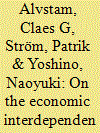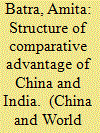| Srl | Item |
| 1 |
ID:
079466


|
|
|
| 2 |
ID:
090019


|
|
|
|
|
| Publication |
2009.
|
| Summary/Abstract |
The paper presents an analysis of the economic relationship between the two most important economies in Asia. Over the last decades, the Chinese and Japanese economies have become more economically interdependent, a development which will, in the long run, impact the countries' political relationship. The paper seeks to answer the question: How can China and Japan gain from the current economic situation, further enhance their relationship and increase their synergies for regional economic development? Data on trade and Foreign Direct Investment are used in combination with primary data from interviews with Japanese and Chinese companies on how they perceive the current business situation and future potential. The result of the data analysis shows that the countries have much to gain from their economic interdependence. The firms see great potential in their respective markets but are concerned about political turbulence. Three possible scenarios for the future economic relationship are presented, including fierce competition on all markets and a leveraging of resources for mutual development between Chinese and Japanese companies.
|
|
|
|
|
|
|
|
|
|
|
|
|
|
|
|
| 3 |
ID:
080031


|
|
|
|
|
| Publication |
2007.
|
| Summary/Abstract |
This paper investigates the extent of competition between China and India in the world and ASEAN markets. The analysis is undertaken using the concept of revealed comparative advantage, relative market shares, long-term trend analysis and statistical tests of convergence. In the context of the ASEAN market the evaluation of competition between India and China has been undertaken with special reference to the prior implementation of the ASEAN-China Free Trade Area relative to the ASEAN-India Free Trade Area. The results suggest that threat perceptions at the product level might currently prevail for both economies from each other across all sectors in both markets even though the intensity of the competitive threat varies across products. However, long-term trend analysis shows that the patterns of comparative advantage of India and China are evolving along divergent paths and, therefore, competition between the two economies might not be a major issue.
|
|
|
|
|
|
|
|
|
|
|
|
|
|
|
|